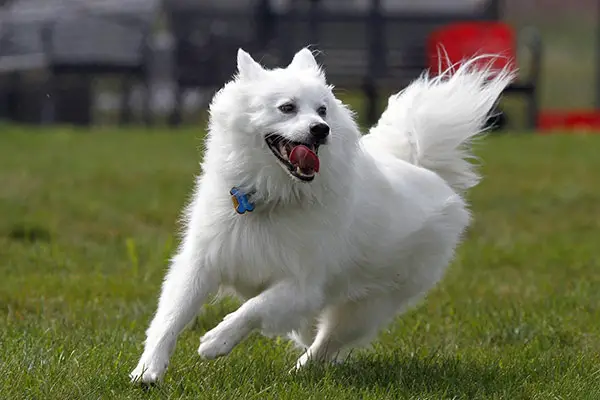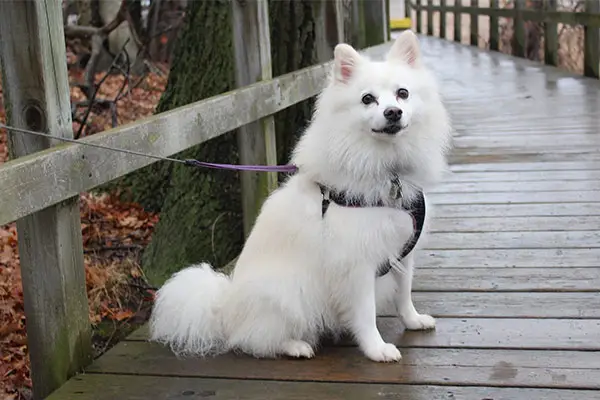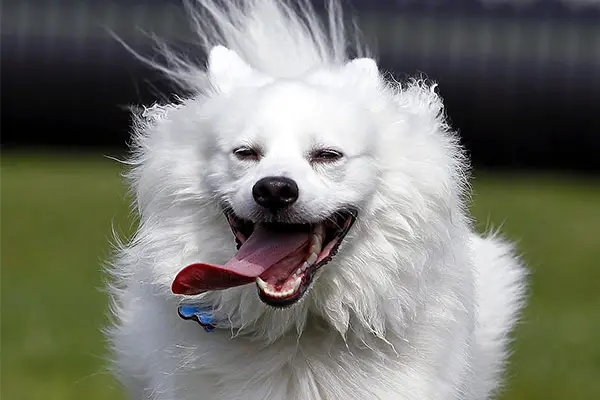American Eskimo Dogs, also known as Eskies, are known for their fluffy white coats. The American Eskimo Dog comes in three different sizes – toy, miniature, and standard – with heights ranging from 9 to 19 inches. They also come with erect, triangular ears, wedged head, and curled tail.
With their beauty, cheerful personality, and intelligence, there’s no wonder that American Eskimo Dogs can capture anyone’s heart. Sadly, these dogs are not made for everyone, particularly for those who can’t give them enough time and care.
Eskies love the company of people, and they especially love it when they are given something to do. For first-time dog owners, you’ll surely be pleased to know that these dogs are easily trainable. They are also adaptable and will be happy in any living environment.

American Eskimo Dog Breed Statistics
| Dog Breed Group | Non-Sporting Group |
| Breed Size | Small to Medium |
| Height | 9-12 inches (toy); 12-15 inches (miniature); 15-19 inches (standard) |
| Weight | 6-10 pounds (toy); 10-20 pounds (miniature); 25-35 pounds (standard) |
| Lifespan | 13-15 years |
American Eskimo Dog Breed Ratings
| Energy level | |
| Exercise needs | |
| Requires attention | |
| Playfulness | |
| Trainability | |
| Shedding | |
| Grooming | |
| Friendly with family | |
| Friendly with kids | |
| Friendly with strangers | |
| Friendly with other dogs | |
| Prey Drive |
American Eskimo Dog History
The true origin of American Eskimo Dogs or Eskies is still unknown. They are said to have an ancient history, but their first appearance in the United States was around the 19th century.
These dogs are members of the Spitz family – fox-like dogs with fluffy coats and tails curled at the back. They are believed to have been brought by German immigrants who sought opportunity in America.
In the late 19th and the early 20th century, Eskies have been popular in circuses and other entertainment businesses where they often do tricks. The beautiful appearance of the dogs, combined with their alert expression, made the crowd love them.
It was also around this time that the American Eskimo Dogs became popular family dogs. Breeders have always boasted every trick these dogs could perform.
By 1913, the United Kennel Club finally recognized the dog breed, and an official dog breed standard was written in 1970. Fifteen years later, the American Eskimo Dog Club in America was formed in 1985.
Although the breed has long been in American since the 19th century, it was only in 1995 that the American Kennel Club recognized them. Now, the dogs currently rank 121st as the most popular dog breed in the US.
These dogs are still beautiful and smart, and they indeed are wonderful family companions.

Temperament
American Eskimo Dogs are known to be playful, perky, and smart dogs. You wouldn’t only love them because of their beautiful appearance, but also with their charming personalities.
Eskies are wonderful family dogs. They are loyal, and they especially love human companionship. Be sure to include them in family activities and keep them entertained.
These are active dogs, and they need to be continuously entertained. If left alone, they can become bored and will cause destructive behavior in forms of barking and chewing. Surrounding your Eskies with toys will be very helpful.
These dogs will make excellent playmates for your children, but toddlers will need supervision. If you have other pets, your Eskie can sure get along well with them and be happier even without you around.
Although undeniably adorable, Eskies are conservative with strangers. Expect them to keep an alert and serious watch at anyone new to your home. Early socialization is necessary, so they maintain a stable temperament.
Training may come easy if done right. As they were used for entertainment shows before, Eskies are naturally smart and quick to learn. They can also be independent and willful, so be sure to be consistent and firm.
Care Requirements
- Nutrition: American Eskimo Dogs need a high-quality and well-balanced diet to remain healthy and happy. They have no special dietary requirements other than making sure that their meal consists of a balance of proteins, fats, carbohydrates, vitamins, and minerals. If you’re going to feed your dog a home-cooked meal, make sure that you only buy high-quality ingredients. You can get proteins from animal meat, fats from fish oils, and carbohydrates from whole grains. You can also give them fruits and vegetables to aid with their digestion. For dog food, choose the premium quality ones that don’t contain fillers and additives that may affect a dog’s digestion. Take note of any allergies your dog might have, and make sure to stay away from those ingredients.
- Grooming: American Eskimo Dogs are well-known for their white and fluffy coats that are very easy to maintain. These coats shed seasonally and will need weekly brushing to remove dead hairs and dirt. This also helps in preventing mats and tangles. During the shedding season, you might need to brush the hair more frequently or daily if possible. Bath them occasionally, once every two to three months, so their skin won’t become dry and irritated. Clean the ears regularly so they won’t get an ear infection. The nails should be trimmed short, too, so your dog won’t feel pain and discomfort.
- Exercise: American Eskimo Dogs are active dogs with lots of energy. They need their regular exercise if you want them to behave properly indoors. Daily walks on-leash should suffice for an Eskie. However, they will be happier if you let them run around a secured yard, supervised. Indoors, you can provide an assortment of toys to keep them entertained. It’s also best to create activities that you can do together. This will help strengthen the bond between you and your Eskie, which will make them the happiest.
- Health: American Eskimo Dogs are generally healthy. However, few health issues are commonly found in the breed. Being aware of these is essential to give them the right care and nutrition to keep them healthy. Some diseases commonly found in the breed are hip dysplasia, Legg-Calve-Perthes disease, progressive retinal atrophy, and juvenile cataracts. Your dog can take some screening tests if you want to detect certain conditions at an early stage. We also recommend meeting at least one of your dog’s parents for any hereditary medical conditions. Continuously monitor your dog’s behavior and be sure to take him for a check-up if there are any changes.
- Lifespan: The life expectancy of American Eskimo Dogs is 13-15 years.
Famous American Eskimo Dogs
- Pierre: An Eskie tightrope walker; America’s most famous performing dog
Fun Facts about American Eskimo Dogs
- American Eskimo Dogs originated in Germany; they were brought to America by their German immigrants.
- They are descendants of the German Spitz.
- These dogs are adorably called Eskies.
- They were originally herders, guard dogs, and hunting dogs.
- They were used as circus dogs in the late 19th century.
- They come in three sizes: standard, miniature, and toy.
- They were recognized by the American Kennel Club in 1995.
Check Out Other Non-Sporting Dog Breeds:
Bichons Frises, Boston Terrier, Bulldog, Chinese Shar-Pei, Chow Chow, Coton de Tulear, Dalmatian, Finnish Spitz, Keeshonden, Lhasa Apsos, Lowchen, Norwegian Lundehund, Schipperkes, Shiba Inu, Tibetan Spaniel, Tibetan Terrier, Xoloitzcuintli

